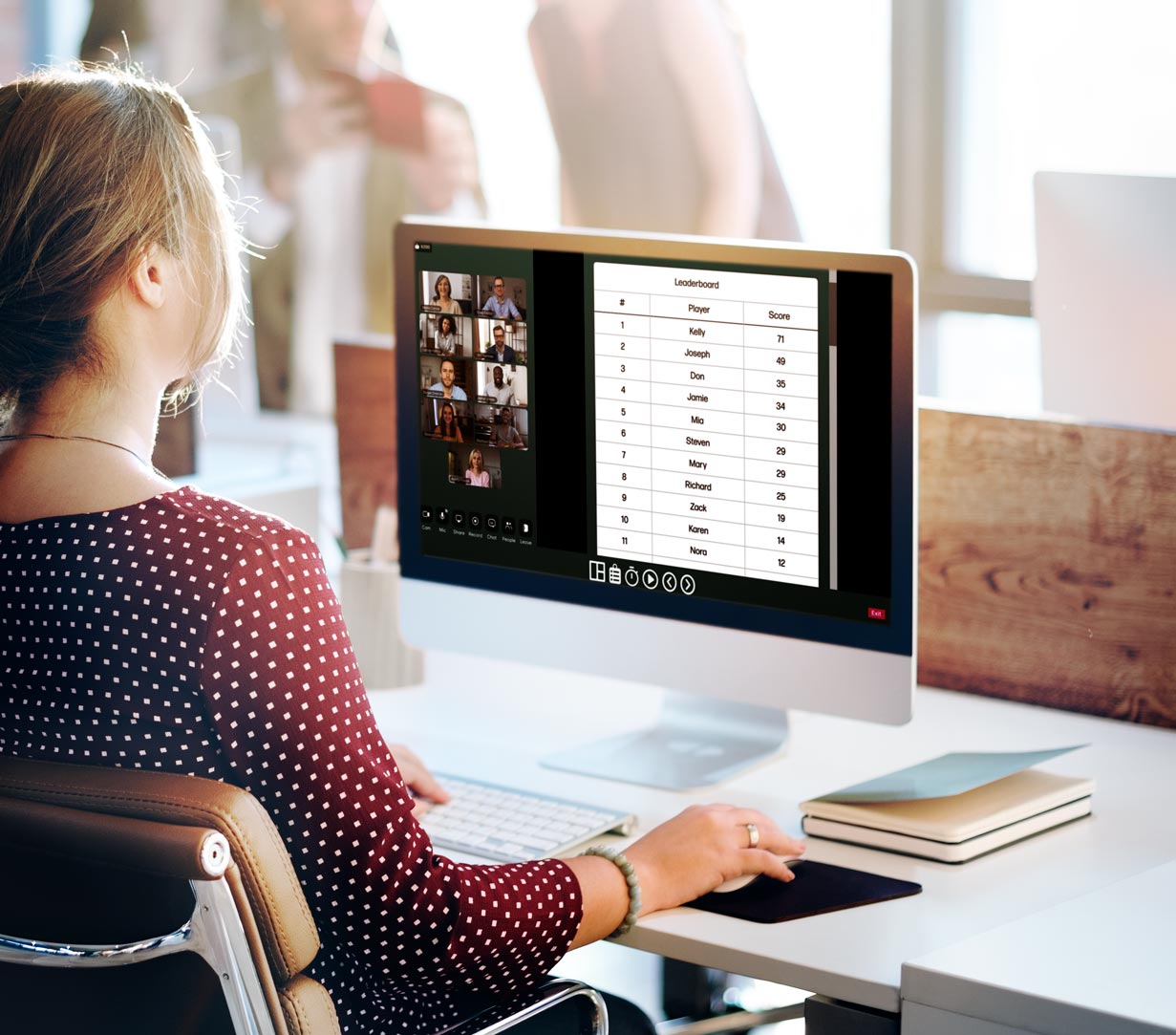Leaderboards present the aggregate score of games as learners progresses through a live training session. They add fun and excitement to any live event or Virtual Instructor Led Training (VILT).
Leaderboard games engage learners and keep them focused on the learning objectives. That’s an important role today, because learners are faced with myriad distractions during training sessions. In this article, we discuss why leaderboards are important, the role of fun and excitement in live events, and provide case histories of leaderboard applications.
We also provide some ideas for creating games with leaderboards.
Why use leaderboards
Leaderboards motivate and engage learners during virtual training sessions. They provide a tangible way to compare and compete with other participants, adding fun and excitement to the learning process. Leaderboards can also be used to track progress and performance, allowing managers and participants to see where they stand in terms of their learning objectives.
In our recent virtual meeting of the company’s executive board, we used a game testing the board members knowledge of the competition. It was a fun way to start a long session.
After ten minutes the CEO and CTO were in a dead heat. For the next three rounds they continued even, accompanied by the hoots and trash talk of their colleagues. Only on the eighth round did the CTO squeak ahead, winning by one point to cheering and applause. What a high energy start to the meeting!
Gamified learning with leaderboards releases a level of excitement, attention, and energy that is rare to find in virtual meetings. That contrasts with typical meetings, 70% of which users characterize as “a complete waste of time.”

Posting the results of gamified challenges encourages people to work together, compete with each other, and communicate better to execute on group goals. When paired with recognition and rewards, leaderboards power learning organizations to higher levels of achievement.
The importance of fun and excitement in live events
Live events are a great way to engage learners. Creating an exciting and engaging atmosphere with immediate feedback keeps learners motivated and focused. Leaderboards add a layer of fun that makes learning enjoyable and pleasurable.

Leaderboard games also increase the level of interaction between learners and instructors. The results of every game are discussed. This help to create a more interactive and engaging learning experience, which can help to keep learners engaged and motivated to complete their learning objectives.
A Case of Virtual Instructor Led Training
Virtual Instructor Led Training (VILT) is an effective way to deliver learning content to learners. VILT allows learners to receive instruction and guidance from an instructor in an online environment. Leaderboard games can be a great way to add fun and excitement to VILT sessions, and can help to engage learners in the learning process.
Virtual teaching is difficult, especially when the classes are 3 hours in length. It’s extremely challenging to get learners involved, participating, and engaged in discussion for the full class time. Leaderboards enhance the virtual classroom by engaging students in a way that is fun and informative.
Leaderboard games can also be used to create challenges and incentives for learners to complete their learning objectives. For example, a leaderboard game can be used to provide rewards for learners who complete certain tasks or reach certain learning milestones. This can help to motivate students to complete their learning objectives and can also help to increase the level of engagement with the learning material.

Generating Ideas for Games
There are multiple different game types that can be created quickly and easy, simply by filling out a form.
We recommend using the microlearning pattern: delivering a learning point, following it up with a gamified challenge, provide the answer, and discuss the results and leaderboard status.
Eight minute microlearning cycles are ideal, with a max of 12 minutes. Every stage in the process is important in providing clear understanding and cementing recall for learners.
To generate game ideas, look at the learning objectives and think of ways to add a competitive element to the learning process. For example, if the learning objective is to learn how to field an objection in a selling situation, create a simulation that challenges learners to practice and improve that skill.
Transform learning from dull and boring by making games that are fun and interesting. Every learning metric will be improved as a result.
Simple game creation
Using REACHUM, creating a leaderboard game is as easy as filling out a form and setting a time limit. The process is quick and intuitive, with 6 types of games built into the platform and with new games coming out regularly.
Within the REACHUM platform, customized games can also be created to match the specific needs of a training session. Imagine “Fantastic Voyage,” a movie about a journey through the human body. If we stopped to identify structures and pathology during that adventure, it would make for a very interesting and memorable learning experience.
Conclusion
Creating a leaderboard game is a great way to add fun and excitement to any training session. Leaderboard games deeply engage learners and keep them focused on the learning content, overcoming the abundant distractions of the digital world. There are a variety of different leaderboard games that can be created, to fit the needs of the learner and the learning objectives.
